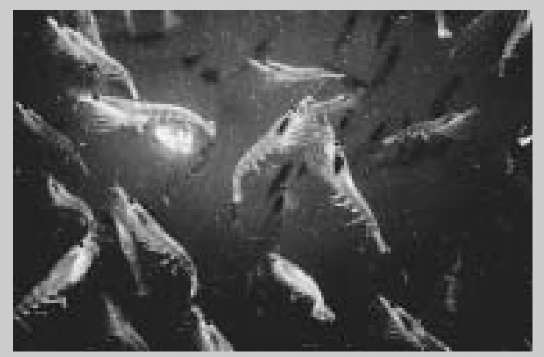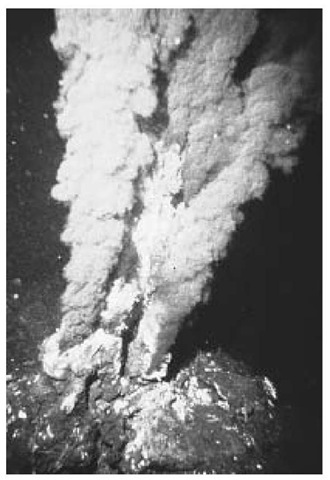All organisms that live in the ocean are subject to the physical factors of the underwater environment. Some of the more important factors that affect marine (ocean) organisms are light levels, nutrients (chemicals required for growth), temperature, salinity (concentration of salt in the water), and pressure. In general, conditions in the ocean are more stable than those on land.
Light
The amount of light in a certain location controls the growth of the single-celled marine algae called phytoplankton. Phytoplankton are the base of the marine food chain, meaning they are the food for other organisms, who then are the food for higher organisms and so forth. These plants convert sunlight and water into the carbohydrates (sugars) they feed on in a process called photosynthesis. Unlike land, where plants generally live on surfaces, in the ocean, light travels through the water allowing phytoplankton to grow over a vertical distance of nearly 500 feet in some locations (about 150 meters).
Light intensity decreases with depth in the ocean and some wavelengths (a property of light that determines whether the light is blue, red, ultraviolet, etc.) of light disappear more quickly than others. Blue light extends the deepest into the ocean, while red light is only present near the surface. Many factors influence how quickly light disappears. Near the coast, there may be high amounts of sediments (particles of sand, gravel, and silt) in the water and light may only extend 50 feet (15 meters). In the open ocean, the water is particularly clear and light may extend down 500 feet (150 meters).
Because the phytoplankton must live where there is light, their predators live there as well. Many fish, crustaceans (aquatic animals with no backbone and a hard shell), and mollusks (soft-bodied animals without a backbone enclosed in a shell) are found in surface waters where phytoplankton grow. Many of these species use light to hunt prey and avoid predators. Light is also important in the life cycles of many fish and invertebrates (animals without a backbone) who use the changing length of the day as a calendar to trigger breeding periods.
Nutrients
Just as people need nutrients to grow, phytoplankton in the ocean also need nutrients. Nutrients are substances that are required for an organism to grow. Phytoplankton absorb nutrients that are dissolved in the water around them. Some nutrients are abundant in ocean water: carbon, oxygen, and sulfur. Others are relatively scarce and become even scarcer when phytoplankton are growing rapidly. The two most important of these are nitrate and phosphate.
Some phytoplankton, like cocolithophores, develop shells made out of calcium carbonate (the same material as mollusk shells). For these organisms, calcium is a nutrient that is often in short supply. Other phytoplankton, like diatoms, produce shells made out of silica, which is also a nutrient that can be scarce in ocean water. Some other nutrients that are needed in very small quantities are iron, copper, magnesium, and zinc.
Temperature
With the exception of the hydrothermal vents (natural springs that vent warm or hot water on the seafloor) in the deep ocean, the range of temperatures in the ocean is much narrower than that found on land. Land temperatures vary from above 120°F (49°C) to well below freezing. Ocean water is rarely above 80°F (27°C) in tropical waters and never below 30°F (-1.9°C), as ocean water freezes at that temperature. Common water temperatures in temperate waters (waters that are not exposed to extremely cold or hot climates) are around 60°F (16°C).
Most animals—including most fish—that live in the ocean are ectothermic, which means that their body temperature is close to that of the water in which they live. The root word ecto means "outside" and the root word therm means "temperature." For these animals, their metabolic rate (the rate at which biochemical processes occur in an organism) is linked to the temperature of water in which the animal lives. For example, if two fish of exactly the same species and size are put in two aquariums, but one is three degrees warmer than the other, the fish in the warmer aquarium will eat more, have a faster heart rate, and swim faster.
Some fish and aquatic insects are endotherms (or, like tuna, are ectotherms that act like endotherms). Endothermic animals generate their own body heat via their metabolism (chemical reactions within the body). The root word endo means "internal." Endotherms can survive in environments that have a very large temperature range. This is demonstrated by whales that migrate from tropical regions to the frigid Arctic waters.
Food Webs
Krill swimming in open ocean waters off Antarctica.
The predator and prey relationships among organisms are termed food webs because the relationships are often drawn as diagrams with arrows connecting the prey and predators. When many different organisms are involved, the arrows begin to look like a web.
The amount of nutrients in the water relates to the complexity of the food web. In waters where there are few nutrients, phytoplankton grow slowly. Their predators, called primary consumers, are few. In turn, the primary consumers have few predators (secondary consumers). This type of environment is said to be oligotrophic (the root word oligo means "few" and the root word troph means "to eat"). The waters off of Antarctica are oligotrophic. There, the phytoplankton grow slowly because of low temperatures. Their primary consumer is the shrimp-like krill and the secondary consumers are baleen whales.
In waters where there are plentiful nutrients, there are many different species of phyto-plankton and they all grow at different rates. This means that there is a variety of primary consumers and, in turn, a variety of secondary consumers. In fact, some animals may be both primary and secondary consumers. This type of food web is called eutrophic (the prefix eu means "true.") In eutrophic food webs, relationships between organisms can become complex and dynamic.
A process called eutrophication occurs when oligotrophic waters suddenly receive an input of nutrients. For example, in places where rain runoff from land contains fertilizers, the additional nutrients stimulate the growth of one species of phytoplankton that outgrows all other species. Sometimes these phytoplankton species clog the gills of fish or result in high growth rates of bacteria. Eutrophication is a serious problem that studies show is increasing, especially in coastal areas.
Hydrothermal Vents
In 1977, scientists from the Woods Hole Oceanographic Institute in Massachusetts discovered life surrounding hydrothermal vents in the deep ocean. The underwater craft Alvin dove to a depth of 10,000 feet (3,000 meters) near the Galapagos Islands. Equipped with a television camera, it returned images of the seafloor to a research ship on the ocean surface. The camera showed jets of very hot water (650°F; 350°C) bursting through the ocean floor. This water contained the mineral sulfur that caused the water to appear black and so the vents have been termed "black smokers."
To the surprise of the scientists, the seafloor around the black smokers was not barren as expected; instead, groups of large marine worms were clustered around the vents. These worms lived in tubes and were about 12 feet (3.5 meters) long. This discovery was an incredible shock because biologists had assumed that no life could exist without photosynthesis, which depends upon energy from the Sun. Rather than relying on photosynthesis, these strange worms used energy from the chemical bonds in the sulfur to build their bodies.
The bodies of the hydrothermal vent worms, given the name Riftia, contain organs that house bacteria. The worms transfer dissolved sulfur out of the water to the bacteria that live inside their bodies. The bacteria then break the bonds of the sulfur molecule to provide energy to the worm. This process of using chemicals to provide energy is known as chemosynthesis. Since the initial discovery of the worms, several species of vent clams, Calyptogena, and some small shrimp have also been found living by chemosynthesis near hydrothermal vents. Since the first discovery by Alvin, many different vent communities have been found throughout the world.
However, endotherms require large amounts of food to provide the energy they need to keep their bodies warm.
Salinity Salinity is the amount of salt found in one kilogram of ocean water. The average salinity in the ocean is 35 parts per thousand (ppt). This means that there are 35 grams of salt per kilogram, or 1,000 grams, of ocean water. In places where rivers flow into the ocean or where there is a lot of runoff from rain, salinity can drop to 6 ppt. In places that receive little fresh water, such as the Red Sea, salinity can be greater than 40 ppt.
Most marine invertebrates have salinities within their bodies that are very similar to the salinity of the water around them. If the salinity of the water suddenly changes, then it can harm the animals by interrupting its natural osmosis. Osmosis is the tendency for the concentration of water to always be the same on both sides of a semipermeable barrier. (A semipermeable barrier allows some materials to pass through in both directions.) The cell barrier of an animal is semipermeable and water can easily flow through it. A change in salinity on the outside of cells will affect the concentration of the water inside cells. For example, if the seawater surrounding a squid suddenly becomes fresher, then osmosis will move water inside squid’s cells. If this happens too quickly, the squid’s cells can burst. On the other hand, if the squid suddenly moves to an area of high salinity, the water from inside the squid’s cells will flow out into the environment. The cells will shrink and the squid could die.
Pressure At sea level, the pressure is 14.7 pounds per square inch (1 kilogram per square centimeter) or 1 atmosphere. This pressure results from the weight of the atmosphere (mass of air around Earth) pressing down on Earth. Most organisms on land do not notice this pressure since their bodies are built to push upwards with the same force. Water, however, is much heavier than air. For every 33 feet (10 meters) an organism descends in the ocean, an additional atmosphere of pressure is added.
Descending to great depths in the ocean is difficult for mammals because of the gas-filled spaces in their bodies. Sinuses and lungs, in particular, are filled with air that has a pressure of 1 atmosphere. These parts of the body collapse when the external pressure becomes too great. Humans can only descend to about 3 or 4 atmospheres (100-130 feet; 30-40 meters). Some whales, like the sperm whale, are able to descend to depths of 7,380 feet (2,250 meters). This is equivalent to a pressure of more than 223 atmospheres.
Most marine animals, like invertebrates and fish, avoid pressure problems by having internal pressures that are the same as those in their surrounding ocean environment. As a result they can move vertically in the ocean without much effect on their bodies.
A black-smoker hydrothermal vent near the Endeavor Ridge off the coast of California.
Sperm whales gather for mating.
WORDS TO KNOW
Ectotherm: An animal that has a body temperature similar to that of its environment.
Endotherm: An animal that can maintain a relatively constant body temperature regardless of its environment.
Eutrophic: Waters with a good supply of nutrients.
Hydrothermal vents: Natural springs that vent warm or hot water into the seafloor.
Metabolic rate: The rate at which the biochemical processes occur in an organism.
Nutrient: Chemical such as phosphate and nitrate needed by organisms in order to grow.
Oligotrophic: Describing a body of water in which nutrients are in low supply.
Osmosis: The tendency for water to have the same concentration on both sides of a semipermeable barrier.
Phytoplankton: Microscopic plants, such as algae, floating in seawater that form the basis of the food web.
Salinity: Amount of salt found in one kilogram of water.
Semipermeable: Descriptive of a material that allows the passage of some molecules and prevents the passage of others.



